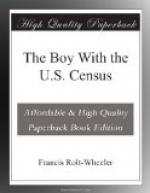“Then do you think the net result of the census is to make it seem that there are more people in the country than really are here?”
“No,” the Inspector replied confidently, “the total figures are an understatement, probably of about one per cent, maybe a little less, but certainly not much more.”
“I think that’s mighty close,” Hamilton said. “But do towns never wish to have small numbers announced?”
“There was only one case, so far as I know,” the other replied, “in which a Business Men’s Association wrote and demanded a recount on the ground that the figures were too big. The reason was a dispute about raising city salaries when a certain population mark was reached.
“And now, Noble,” he continued, moving on toward the train platform, “we want to look into the question of statistics in New York carefully. Personally I believe the work has been as well done as possible, and I know the Director is satisfied, but one or two little matters have come up, which want looking into.”
Being on a midnight train, Hamilton had no chance for further talk with the Inspector; but it was quite a home-coming when, after passing through the great tunnels under the Hudson River, he found himself next morning among the skyscrapers of New York again.
“I suppose every one feels the same way about his own town,” Hamilton said, “but it always seems to me that you feel the bigness of things more in New York than anywhere. In Washington there always seems lots of time to do everything you want, but New York is just made up of hustle. You’ve got to know what you want in this city and you’ve got to do it in a hurry, before some one else gets there first.”
“New York certainly is hurried and restless; I can’t say I like the noise and the skyscrapers,” replied Burns.
“But it’s great the way those buildings tower up,” the boy exclaimed enthusiastically, “the low houses and poky ways of older and smaller cities look as though they were made for dwarfs, after living in the New York streets.”
“Yet there are taller buildings, in other places, even in Europe,” the statistician remarked.
“Spires!” answered the boy, “propped up by buttresses and flying buttresses and all the rest of it so as to keep them from falling. Look at those,” he added, pointing at the skyscrapers before him, “they’re not afraid to stand by themselves; they mean something, they have a use, while a spire just sticks straight up, pointing at nothing and being of no service unless it is to hang bells in a belfry. I don’t care what people say about those crazy old tumble-down buildings of the Middle Ages, they may be beautiful and all that, but they’re useless nowadays. The New York skyscraper is the greatest example of architecture in the world because it best does what it was built to do.”
“You are enthusiastic, Noble,” said his friend.




